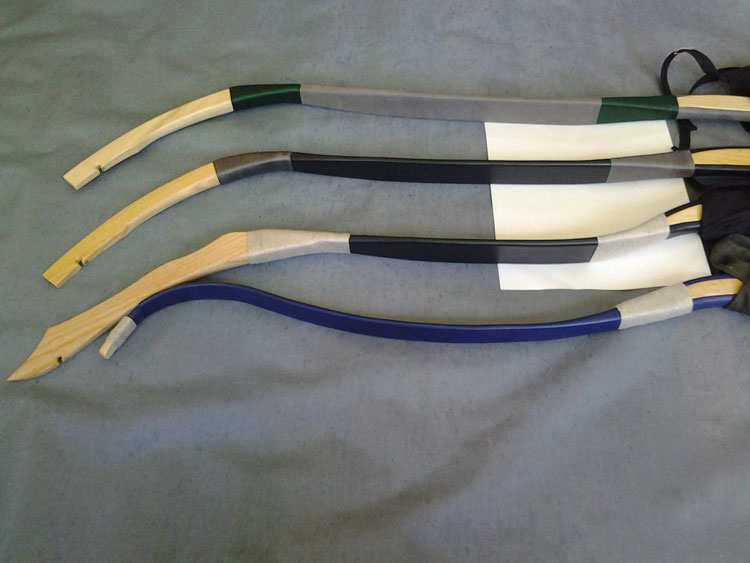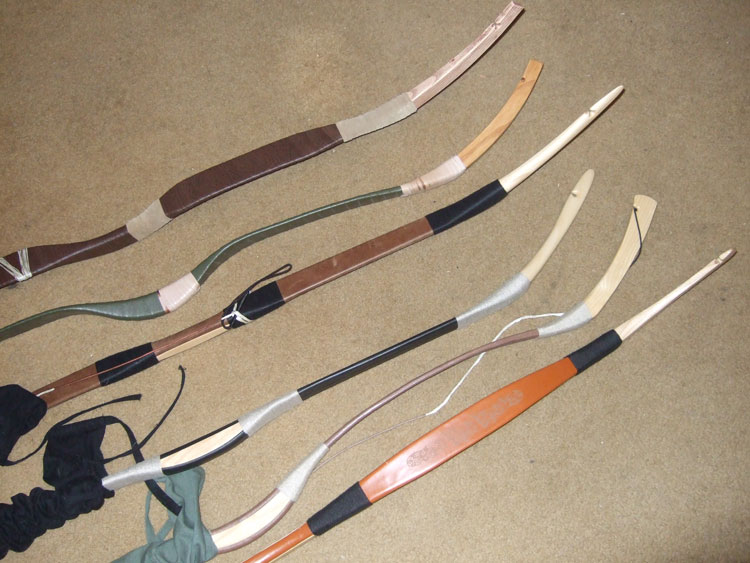Bows from Hungary
Archery Bows
The bows are handmade in Hungary by Kassai kfd. I started importing Kassai bows in 1996. Kassai's factory webpage is: http://www.lovasijaszat.hu/
They are all fine quality rugged bows. In a variety of models to fit variety of body sizes and a variety of styles of archery. I have bows here for hunting, target archery, very tall (long draw length) archers, very short (short draw length) archers, and of course horseback archery.
These bows are based on a different line of development than most available in North America. Kassai has unearthed the 4,000 years of research and development of archery in his part of the world and applied it with modern materials.
I offer a few recurve bow models. There are lots of recurve bows available in modern North America so I shall not describe them much. Historically they have been made 2,000 years BCE or older. Persian Empires, Chinese Empires and the Scythian and nomad cultures of the steppes used them as their best bows for the hunt and war. Simple recurve bows were overshadowed by the invention of the static recurve bow about the beginning of the Current Era. As they are easier to make they were still made, just relegated to light weights and children's bows.
What we here and now refer to as "Horsebows" are the static recurve bow. Crudely explained as the body of a recurve bow with a pry-bar attached to each end to improve the archers leverage. This gives you bows of great performance. A draw smoother than any you have drawn. Velocity you expect only from a compound bow, and these Hungarian bows I have selected to sell are so well made they have no hand shock or string hum.
I have customers who had automatically put string silencers on their first horsebow - as their recurve bow experience told them all hunting bows need string silencers- then took them off a few weeks later and never use silencers again.
A master archer and horseman, Mr. Kassai has designed bows based upon years of research into the Scythian, Hun, Avar, Magyar, and Mongol historic styles. Highly related are the Khazar, Russian, Seljuk Turk, and Korean bows. Mr. Kassai references include archeological digs in his country and elsewhere, historic texts, paintings, illuminations, and Magyar verbal histories.

Ashwood and Fiberglass Bows
The handle and syhas (those hockey stick shaped ends of the bows) are ashwood, the bellies are fiberglass. The wood and fiberglass pieces interlock and their joints wrapped together with nylon thread. Then the bellies are wrapped in leather and the joints again wrapped and glued using nylon or cotton cord. The wrapping is used to protect the fiberglass from the UV rays of the sun and reproduce the traditional look. All fiberglass is protected and hidden under wood or leather. The leather has been finished to be more water proof than your hiking boots.
"Do not follow your ancestors. Follow what they had followed."
These are the words said by Lajos Kassai, the most famous horseback archer when asked why the modern bow reconstructions are made from plastic-glass fiber composit instead of wood.
The ancient bow makers made their bows with cutting edge technology and materials available at the time to make the best bows possible. We follow the same route, that is why, at the beginning of the 21st century, instead of wood we use plastic- glass fibre composit for making our bows since at present this is the best material available for the purpose.
The bellies of the ancient horsebows were wrapped in leather or birch bark to keep dry the water soluble glue that held together the tendon, wood, and horn sandwich which made them so much more efficient than simple wood construction. Of course if it were easy everyone would have used them, the horn, wood, sinew lamination was and, even with modern glues, still is much more difficult to make and maintain.
Like the ancient bows, these modern ones are made without arrow rests. So will be used right- or left- handed. Most folk use a leather glove to protect were the arrow passes over the side of the bow hand. If you are not certain you can adapt to not having a rest, a rest can be added very simply, binding a rest shelf on with leather or string.
The pull is very smooth. The release is easy and the energy ALL goes into the arrow, there is no energy left to cause hand shock or "thrum" the string! Most of the models are marked with the draw weight measured at 30". The Hun does not stack, even at 38". This is accomplished by the leverage of the syhas giving the archers hand a mechanical advantage over the increasing resistance of the bow as it bends. The velocity of the cast is noticeable faster than a longbow or recurve of similar poundage. When you draw these bows, you pull against more weight for more of the length of the draw. As this extra energy comes from your large shoulder muscles' you barely notice any extra effort.

Some suggested modifications to shooting style to accommodate a horsebow:
- Cant the bow 10 degrees to negate the lack of an arrow rest as do most recurve bows.
- Do not lock the elbow of the bow arm, a slight bend gets the forearm out of the way of the string, no need for a bracer, and steadies the bow hand. A locked joint tends to shake more than a controlled bent joint.
- These bows may be used either in the Eastern (thumb ring release) or Western (finger release) style of shooting. North American archers "all" shoot finger release.

Which model should you read about first?
- Are you quite tall, or have a draw length over 30 inches?
Greyhound, Metal Greyhound, Stag/Hun, The Bear - Are you quite short, or use a draw length under 26 inches?
Scythian, Swallow Short - Are you a bit less tall than average?
Hunter, Buzzard/Magyar Sport, Swallow Long - Are you looking for a bow for a child, so need a bow that will stay useful through a lot of growth?
Pony, Swallow Short, Swallow Long - Plan to hunt?
Panther, Greyhound, Metal Greyhound, Hunter, Raven, Wolf/Mongol 1 or 2, The Buzzard/Magyar Sport, Metal Lynx, Lynx extra, Lynx 2 - Horseback archery?
Hun or any of the others except the Vazul (which we no longer carry in the US) - Want a real war bow, up to 110 pounds?
The Bear - Experienced archer who wants a precision instrument?
The Stage/Hun, Any Bow in the Metal Series Bows - Not certain, or want to do everything?
Raven, The Wolf/Mongol 1&2, Any of the Lynx Variants - On a budget and still want a really good bow?
Lynx 2